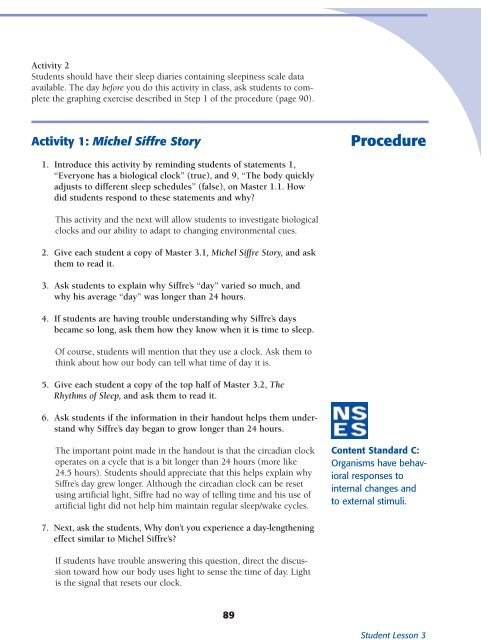Biological - NIH Office of Science Education - National Institutes of ...
Biological - NIH Office of Science Education - National Institutes of ...
Biological - NIH Office of Science Education - National Institutes of ...
Create successful ePaper yourself
Turn your PDF publications into a flip-book with our unique Google optimized e-Paper software.
Activity 2<br />
Students should have their sleep diaries containing sleepiness scale data<br />
available. The day before you do this activity in class, ask students to complete<br />
the graphing exercise described in Step 1 <strong>of</strong> the procedure (page 90).<br />
Activity 1: Michel Siffre Story<br />
Procedure<br />
1. Introduce this activity by reminding students <strong>of</strong> statements 1,<br />
“Everyone has a biological clock” (true), and 9, “The body quickly<br />
adjusts to different sleep schedules” (false), on Master 1.1. How<br />
did students respond to these statements and why?<br />
This activity and the next will allow students to investigate biological<br />
clocks and our ability to adapt to changing environmental cues.<br />
2. Give each student a copy <strong>of</strong> Master 3.1, Michel Siffre Story, and ask<br />
them to read it.<br />
3. Ask students to explain why Siffre’s “day” varied so much, and<br />
why his average “day” was longer than 24 hours.<br />
4. If students are having trouble understanding why Siffre’s days<br />
became so long, ask them how they know when it is time to sleep.<br />
Of course, students will mention that they use a clock. Ask them to<br />
think about how our body can tell what time <strong>of</strong> day it is.<br />
5. Give each student a copy <strong>of</strong> the top half <strong>of</strong> Master 3.2, The<br />
Rhythms <strong>of</strong> Sleep, and ask them to read it.<br />
6. Ask students if the information in their handout helps them understand<br />
why Siffre’s day began to grow longer than 24 hours.<br />
The important point made in the handout is that the circadian clock<br />
operates on a cycle that is a bit longer than 24 hours (more like<br />
24.5 hours). Students should appreciate that this helps explain why<br />
Siffre’s day grew longer. Although the circadian clock can be reset<br />
using artificial light, Siffre had no way <strong>of</strong> telling time and his use <strong>of</strong><br />
artificial light did not help him maintain regular sleep/wake cycles.<br />
Content Standard C:<br />
Organisms have behavioral<br />
responses to<br />
internal changes and<br />
to external stimuli.<br />
7. Next, ask the students, Why don’t you experience a day-lengthening<br />
effect similar to Michel Siffre’s?<br />
If students have trouble answering this question, direct the discussion<br />
toward how our body uses light to sense the time <strong>of</strong> day. Light<br />
is the signal that resets our clock.<br />
89<br />
Student Lesson 3

















